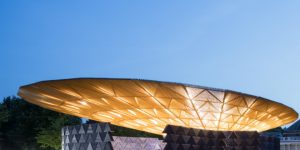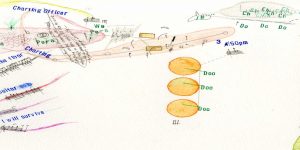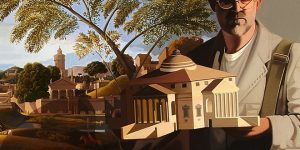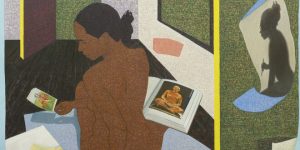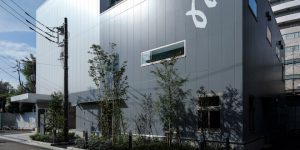ADM Gallery presents Lyota Yagi and ‘Exceptions of Rule: Counterpoints to Truth’
ADM Gallery considers the information age in two exhibitions

Installation view of Song-Ming Ang, ‘Email Disclaimers’, 2018, metallic foil on paper, 29.7 x 42 cm each; and Song-Ming Ang, ‘You are receiving this email because’, 2018, mixed media installation, variable dimensions. Image courtesy Song-Ming Ang and ADM Gallery.
The ADM Gallery opens its 2018 season with exhibitions addressing artists responding to the perpetuation of information through advancements in technology. Gallery 1 houses a solo exhibition by Lyota Yagi, while Gallery 2 hosts the group show ‘Exceptions of Rule: Counterpoints to Truth’. Both will run from 2 February to 7 April.

Lyota Yagi, ‘Distant Time, Near Time’, 2008, synchronous motor and scale model. Image courtesy Lyota Yagi and Nobutada Omote.
‘What is Essential is Invisible to the Eye’
Kyoto-based artist Lyota Yagi’s solo show includes works from 2005 to the present. The artist is known for his sound-based work using a wide range of media, deconstructing their conventional modes of usage and reception, and examining the characteristics of an artistic medium or object, at times recreating mechanical devices that engage with noise and randomness as productive modes of art-making.

Lyota Yagi, ‘Portamento’, 2006, porcelain clay, record and video. Image courtesy Lyota Yagi.
Yagi often creates visual form from sound in his works. In ‘For the Ontology of Letters’ (2017, 2006), Yagi transforms magnetic tape, which became obsolete when digital files replaced analog recording of sound, into text. In ‘Portamento’, wet clay is placed on a record on the turntable, with intervention by ceramist Toshio Matsui. The sound and the clay’s form affect each other depending on the way the hands touch the clay.
‘Vinyl’ (2005-2008) is one of the artist’s signature works, which uses a similarly unusual material. It plays the music of classical music composers Frederic Chopin, Claude Debussy and Henry Mancini from records made by freezing water in a silicone mould. The sound becomes distorted as the ice melts and finally disappears when it completely turns into water, in a reflection of the opaqueness of memory. Just like the story ‘Le Petit Prince’ by Antoine de Saint–Exupéry, which gave the exhibition its title, Yagi’s works beseech us to see what is in front of us through fresh eyes.

Lyota Yagi, ‘Sea and Metronome’, 2009, video, 2:25 mins. Image courtesy Lyota Yagi and ADM Gallery.
Yagi was born and raised near the ocean, which has influenced his work, such as in ‘Sea and Metronome’ (2009), an experiment to compose natural and artificial rhythms in a single work, inspired by German philosopher and psychologist Ludwig Klages’ ‘Vom Wesen Des Rhythmus’. The artist says,“ I made the assumption that there are two different times in the world, and composed the time in the video using an arithmetic series.” Another work alluding to his upbringing is ‘Sea Under the Table’ (2010), which is composed of a table with two pairs of infrared headphones. The table represents the surface of the water, and one hears the sound from above the sea on the tabletop and the sounds underwater under the table.

Installation views of Pak Sheung Chuen’s works. Image courtesy Pak Sheung Chuen and ADM Gallery.
‘Exceptions of Rule: Counterpoints to Truth’
The group exhibition is an amalgamation of responses to new data. As information is delivered to us at an unprecedented pace, we are discouraged from reflecting upon it, let alone verify its truthfulness. In this exhibition, Song-Ming Ang (Singapore), A.R. Hopwood (United Kingdom) and Pak Sheung Chuen (Hong Kong) address the thin line that separates fact and fiction in the information age, and push us to be more vigilant about what is presented to us.
Ang’s new works relate to Yagi’s works in looking at sound, but in cultural and socio-political dimensions. He looks particularly at legalese employed within mass communication, such as “echo”, “chorus” and “dissonance” for the perpetual dissemination of all information as truth, to make the viewer question what is real and not real, and how others’ responses have an impact on what we think about any matter.

Song-Ming Ang (in collaboration with Jason Maling), ‘Postcards from the Future’, 2018, digital/offset print on paper, 14.8 x 10.5cm each. Image courtesy Song-Ming Ang and ADM Gallery.
Ang describes the works to be broadly split into two categories. “Some are collaborative works that revolve around the social aspects of music, while the others focus more on mass communication,” he says. “I’m collecting information that I find interesting and making lists out of them, and then presenting them in ways that accentuate certain characteristics of the information. When it’s done the right way, I think a lot of undertones can emerge from such mundane information.”
Hopwood shows an ongoing work, ‘False Memory Archive’, which exposes the malleability of memory and how that shapes both the individual and collective perceptions of life, through his conducting of pseud-research and creation of public responses. He says, “It encourages the audience to critically reflect on their own past and to understand some of the implications of distorted memories in a legal and therapeutic context.”
In essence, Hopwood would like the viewer to question the power of memories. “It’s not about trying to persuade the viewer that everything they know is wrong or that all of our autobiographical memories are fundamentally flawed,” he says. “In fact our memories of past events are pretty extraordinary. They may be just a gist of a past event but this gist is usually enough to help us reflect meaningfully on our past in order to help us negotiate the everyday.”

A.R. Hopwood, ‘False Memory Archive: Erased UFOs’, 2012 – 2013, variable. Image courtesy A.R. Hopwood and ADM Gallery.
Pak’s works look at sites of political renegotiation. In this exhibition, his work focuses on Hong Kong in the post-Umbrella Movement era, and looks at ways in which the individual can understand and react to the new status quo.“The authoritarianism ruling of Singapore government is a model Hong Kong government want to follow,” says the artist. “I am primarily comparing the system (especially the legal system) between Singapore and HK”.
All in all, the works in the ‘Exceptions of Rule’ exhibition challenge dominant narratives circling and developing in society, and reveal the agency that artists have in challenging the status quo and inciting others to do the same.
Both exhibitions show insightful works that are thought-provoking and highly relevant to our lived realities, and are not to be missed.
More information at adm.ntu.edu.sg/newsnevents/adm-gallery.





